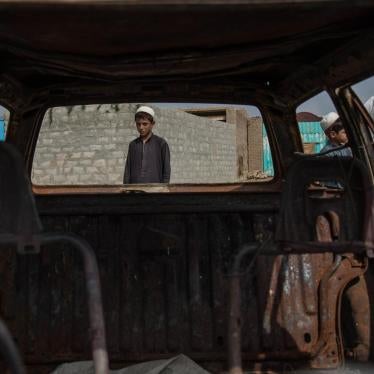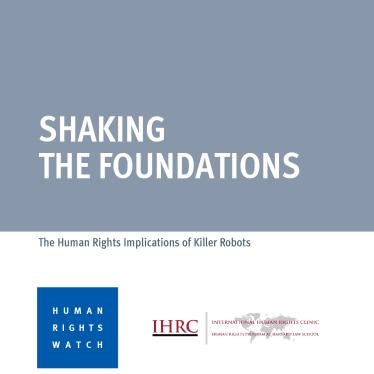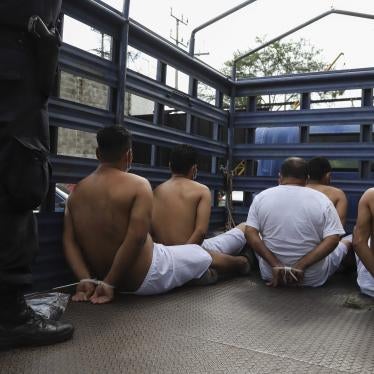On his way to the opening of the UN General Assembly in New York last month, President Barack Obama stopped at the Clinton Global Initiative, where he announced a ban on U.S. use of antipersonnel landmines everywhere except the Korean Peninsula due to its “unique circumstances.” He pledged, “We’re going to continue to work to find ways that would allow us to ultimately comply fully and accede to the Ottawa Convention,” as the U.S. government prefers to call the 1997 Mine Ban Treaty.
The policy announced September 23 also commits the U.S. to destroy stockpiled antipersonnel mines “not required for the defense of the Republic of Korea” and to “not assist, encourage, or induce anyone outside the Korean Peninsula to engage in activity prohibited” by the Mine Ban Treaty.
An updated Questions & Answers document issued by Human Rights Watch this week unpacks the latest policy as well as the new policy banning U.S. production and acquisition of antipersonnel mines, announced on June 27. U.S. exports of antipersonnel mines were banned back in 1992 at the initiative of Senator Patrick Leahy, the key congressional champion on the issue.
These steps constitute a comprehensive U.S. ban on antipersonnel mines except for the Korean Peninsula. They show that the U.S. is serious about working to comply with the Mine Ban Treaty by aligning its policy with its key requirements. But President Obama need to finish the job and ban U.S. mine use in Korea if it is to join the treaty.
The U.S. has said the Korea exception is necessary while the Defense Department undertakes a “high fidelity modeling and simulation effort to ascertain how to mitigate the risks associated with the loss of anti-personnel landmines.” Further information is needed on this study, including when it will be completed.
The need for the study is questionable, as the U.S. has spent more than $1 billion over the past 20 years to develop and produce systems that could be considered alternatives to antipersonnel mines. During this time the U.S. has fought a wide range of conflicts, both high- and low-intensity in a variety of environments, and has demonstrated that it can employ alternative strategies, tactics, and weaponry that avoid using antipersonnel mines.
Further, the landmines already placed in and near the Demilitarized Zone between North and South Korea are the responsibility of South Korean forces and not the U.S. The U.S. does not maintain any minefields globally after removing its mines from around Guantanamo Naval Base in Cuba from 1996-1999.
President Obama should insist that the Pentagon study be completed swiftly so that the Korea caveat can be removed from the ban on landmine use. As the U.S. Campaign to Ban Landmines has urged, the accession documents for the Mine Ban Treaty should be prepared so President Obama can send them to the Senate for action before he leaves office on January 21, 2017.
It is not yet clear how the administration’s 2014 landmine policy announcements will be codified, but previous landmine policies announced in 1996, 1998, and 2004 were all issued as presidential directives. While working expeditiously to remove the Korea exception, the U.S. should take a number of steps in the context of the new policy to ensure that US mines are never used again elsewhere.
To implement the 2014 policy, the Defense Department should immediately issue an administrative order permanently suspending all use of antipersonnel mines in combat or training outside of the Korean Peninsula. All U.S. stockpiles of weapons containing antipersonnel mines and munitions containing a mix of antipersonnel and antivehicle mines that are not required for the Korean Peninsula will need be removed from stocks in the U.S., on supply ships, and in storage facilities overseas, and transported to a destruction facility.
It’s essential that the U.S. be transparent in its implementation of the new policy, including by making public information on the types and quantities of antipersonnel mines to be removed from active inventory and destroyed, as well as the destruction plan, with the timeline and cost.
In making his announcement, President Obama cited President Bill Clinton’s pledge at the 1994 UN General Assembly committing the US to work for the “elimination” of antipersonnel landmines. Clinton confidently predicted that “ridding the world of those often hidden weapons will help to save the lives of tens of thousands” of people. He was right.
As reporting since 1999 by Landmine Monitor shows, the number of new victims from antipersonnel mines and explosive remnants of war has decreased dramatically every year since the treaty’s adoption, from more than 20,000 victims each year to fewer than 5,000.
This can be attributed to the treaty’s impact over time in stigmatizing the weapons and nearly halting new use, and to the extensive mine clearance efforts funded by the U.S. and others.
The White House acknowledged the strength of the treaty in its announcement, noting the participation of “all of our NATO Allies” among the 162 states parties. It said the new landmine policy brings U.S. practice “in closer alignment with a global humanitarian movement that has had a demonstrated positive impact in reducing civilian casualties from [antipersonnel landmines].”
While President Clinton was the first world leader to call for a landmine ban and Senator Leahy has led the charge in Congress, President Obama said: “This started in civil society. That’s what prompted action by President Clinton and by myself.”
President Obama credited the International Campaign to Ban Landmines and “tireless advocates like Jody Williams”—co-recipients of the 1997 Nobel Peace Prize for their efforts—and said: “Promoting civil society that can surface issues and push leadership is not just in keeping with our values, it’s not charity. It’s in our national interests.”
In July, the author of the fast-track diplomatic Ottawa Process that created the Mine Ban Treaty, former Foreign Minister of Canada Lloyd Axworthy reflected on how close his team came to consenting to US requests to amend the draft Mine Ban Treaty text during the September 1997 negotiations. He described “an intensive effort of conversations” with President Clinton and senior administration officials over US “redline” requests that included an exception for the Korean Peninsula.
Axworthy said that “Mr. Clinton was ready to come onside” but then “the Pentagon pushed back, and by 11 that night, the President had backed away.” The U.S. delegation announced the withdrawal of the U.S. proposals and the next day the treaty was adopted.
It’s doubtful that the far-reaching text proposals would have been accepted by the nations participating in the negotiations due to the rule of procedure that required that two-thirds of the participating states agree to new text amendments. Perhaps if the U.S. had engaged earlier in the Ottawa Process in a meaningful way the result would have been different.
But as it turned out the Pentagon’s unwillingness to compromise was responsible for ensuring that a strong text was adopted in Oslo on September 18, 1997. Campaigners, myself included, were jubilant that the text had not been weakened. We knew that over time it would be easier to deal with the issues on a country basis rather than having to deal with a weakened global norm.
Today U.S. diplomats should not feel embarrassed by their government’s lack of action on the Mine Ban Treaty, but rather emboldened to pitch in and work on its behalf. But it’s not enough for the U.S. to align its policy with the treaty; the Korea exception should be overcome so the U.S. can join the treaty and help realize our common goal of a world free of landmines.








